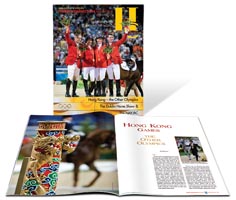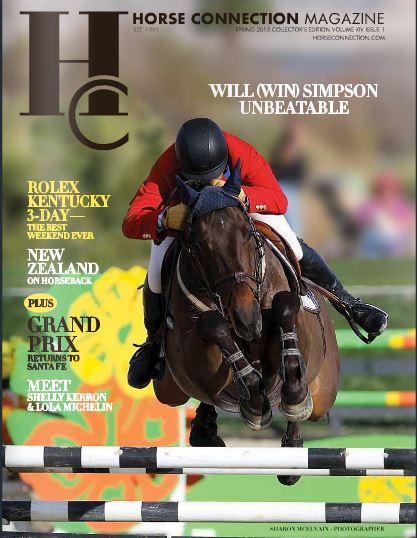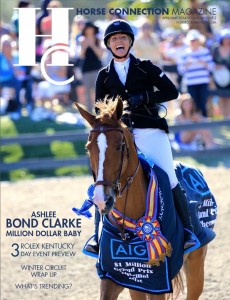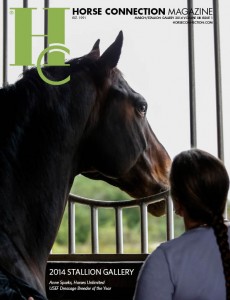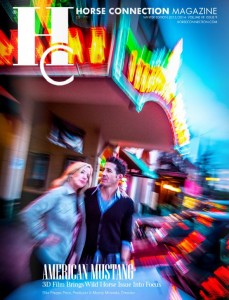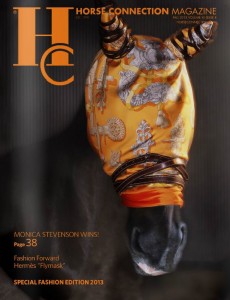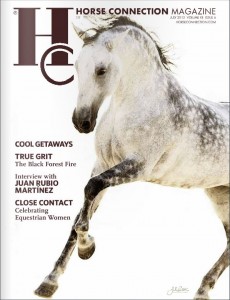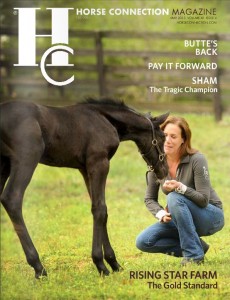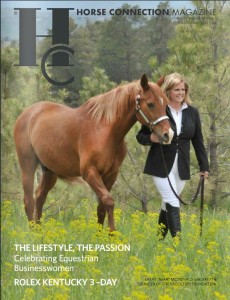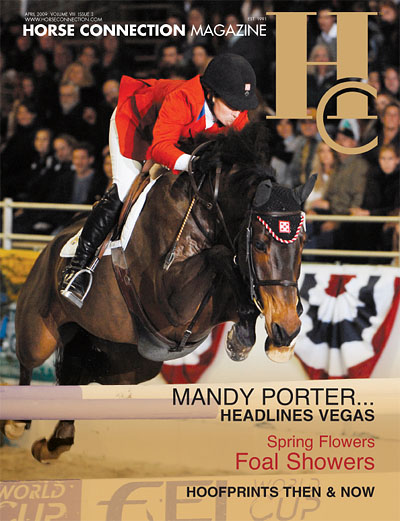
In the Hoofprints of History- April 2009
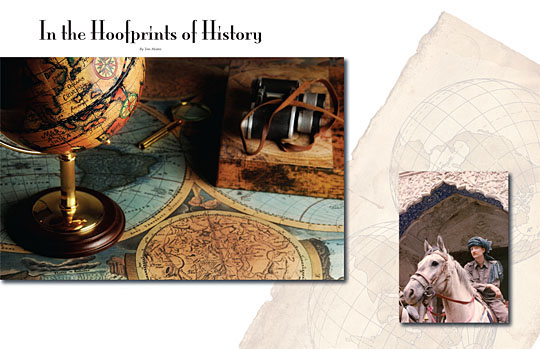
Tom Moates
Twelve men have walked on the Moon,
yet no human has ever ridden around the Earth!
No one speaks more fluently on the subject of equestrian exploration than CuChullaine O’Reilly. That is understandable since, along with his wife Basha, he has worked for nearly a decade preserving, protecting and promoting the ancient art of horse travel. CuChullaine spent more than thirty years studying equestrian travel techniques on four continents. He made lengthy trips by horseback across Afghanistan and Pakistan before leading the Karakorum Equestrian Expedition through five mountain ranges. CuChullaine was thereafter made a Fellow of the Royal Geographical Society.
He and Basha are now setting off on the first continuous, around-the-world equestrian expedition. The journey will cover 12,000 miles, cross eleven countries, last two years and be the most highly developed diplomatic and scientific equestrian mission ever undertaken. www.theworldride.org
CuChullaine is the author of Khyber Knights, the tale of his adventures in Pakistan, and The Horse Travel Handbook. A dedicated equestrian reformer, he is now working to establish the world’s first equestrian archaeology program.
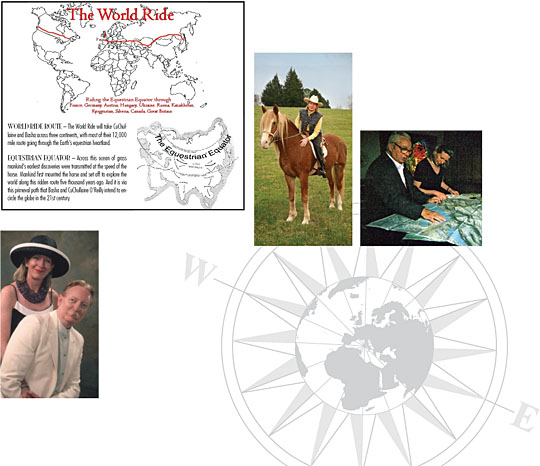
This exclusive interview is the first CuChullaine has granted on the subject of the upcoming World Ride.
What prompted you to attempt this circum-navigation of the globe on horseback?
“Twelve men have walked on the moon but no human being has ever ridden a horse around the Earth. Isn’t that a staggering thought? We hope our trip will not only inspire a new generation of equestrian explorers but spark a renaissance of mounted travel.”
Why hasn’t a horseback circumnavigation of the globe been accomplished before, and are you aware of others who have tried it?
“This is a flat-earth moment for the established equestrian world because the implications of a successful global ride will transform the way humanity thinks about horse travel. But even though mankind has been riding for seven thousand years, circling the globe was deemed impossible. And that’s a reasonable assumption when you consider how much time it requires, how much money it costs, how much equestrian travel knowledge and raw luck you need. That’s why even though The Guild has documented more than a million miles by equestrian explorers; only one Long Rider ever seriously took on the challenge of the World Ride. That was an American named ‘Diamond Dick’ Tanner. He set out from Nebraska in 1893 but only reached New York before he gave up.”
What is important about the route you have chosen to travel?
“Our route covers 12,000 miles, crosses eleven countries and will last two years. The ride starts in Paris where modern equestrian travel began back in 1889 when Cossack Officer Mikhail Asseyev rode there from Russia. Thus the Eiffel Tower serves as the beacon for the journey’s start and finish. We then ride our two horses east through France, Germany, Austria and Hungary. From there we ride through Ukraine, following the Equestrian Equator across Central Asia. Then into Russia, where we’ll have to travel along the “Road of Bones.” Political prisoners, thousands of whom died and whose bodies became part of the road, built this notorious trail through Siberia. After that our mounts and we fly to Canada and ride across that horse-friendly country. From Canada, we take to the air again and fly to Scotland. Then it’s just a matter of riding south to London and then returning to Paris.”
What is the Equestrian Equator and how does it tie into the World Ride?
“The Equestrian Equator is a term I invented to describe the ancient grassland that encircled a great portion of the Earth six thousand years ago. In the Bronze Age there were dense Siberian forests to the north, and inhospitable deserts to the south, that acted as natural boundaries for a vast steppe extending from Europe to China. And while scholars are fond of talking about the Silk Road, the Equestrian Equator existed centuries before that commercial enterprise. It was along this grass-covered beltway that mankind first mounted the horse and set off to explore the world. That’s why we’ve chosen to ride along as much of this primeval path as possible, and highlight the need to research humanity’s equestrian roots.”
What makes you two qualified to undertake this epic equestrian journey?
“Basha and I are the only equestrian explorers who made journeys prior to meeting. So we were both Long Riders in our own right before we married. And that’s important because we know how tough a journey like this is. It’s hard for modern people to comprehend how cut off you become from what’s considered normal. Food, warmth, sleep, safety. Forget it. You can’t take any of them for granted when you swing into the saddle. Instead you ride through every kind of weather and face every type of hardship, and you never quit. Ever. But this is the toughest ride ever undertaken.”
Basha rode her famous Cossack stallion, Count Pompeii, from Russia to England on one of her previous Long Rides. Will he be making the entire journey?
“I pity the poor government official who tries to separate Basha from Count Pompeii. Talk about nuclear winter. So yes, Pompeii will be Basha’s mount for the entire journey. Meanwhile, the Royal Friesian Horse Foundation (FPS) in the Netherlands is helping me search for a suitable gelding. And while the world is awash with horses, most people don’t realize how hard it is to locate a Road Horse, because when you’re a Long Rider you put your life in the care of a horse who is expected to do his own thinking.”
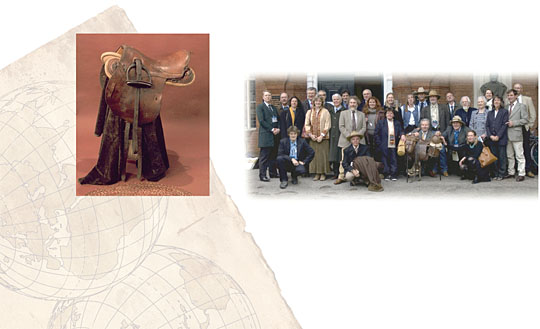
What does it mean to be a Long Rider?
“Well any definition of a Long Rider has to include bravery, resolve and compassion for our horses. And I can’t stress the horses enough, because even though equestrian explorers acknowledge the inherent perils that await the horse and rider, no member of The Guild condones any expedition that subjects the horses to needless suffering. That’s why the guiding stars of any Long Rider are ethical horsemanship, principles not profits, a devotion to preserving the public’s trust, and loyalty to one another. In a word, chivalry, whose root word is ‘cheval,’ horse.”
How does this incredible first Long Ride around the world articulate that?
“Unlike the competitive horse world, The Guild doesn’t have an obsession with mileage. Our members have set an assortment of records during the course of their travels. But we don’t promote a needless quest for kilometers, or the lightning flash crossing of continents. Instead we encourage our members to undertake a life-changing equestrian journey that doesn’t just explore the unknown portions of the world, but their own souls as well. That’s why being a Long Rider is more than just a matter of miles. By riding around the Earth, Basha and I are demonstrating that any courageous person, allied to a devoted horse, can set off to explore their own personal portion of the globe.”
On your World Ride website, you discuss the end of the age of national exploration, where the goal was the conquest of a neighboring nation’s natural resources or the race to plant a flag on the highest peak or a distant Pole. In contrast, you believe that Long Riders are “citizen explorers.” What do you mean by that?
“It surprises many people to learn that equestrian travel offers an alternative to the competition-based, nationalistic horse world existing today. Being a Long Rider isn’t about winning a ribbon in the ring. It’s about making a lasting mark in your own life. It’s about ordinary men and women accomplishing extraordinary things on everyday horses. The World Ride is a journey about courage, not records, about people, not personal heroics. And while some might be tempted to peddle it as a reality-show television gimmick, it’s not. Despite the mileage and the hardships, this is a simple expedition, designed to link humans and horses via the saddle and the Internet so as to encourage all of us to resume speaking our common ancestral tongue, which is ‘horse’.”
Please explain the equine DNA project connected to the World Ride.
“Talk about history! En route Basha will be working with scientists and horse owners to collect hair samples from every known horse breed, thus creating the first complete equine DNA chain.”
Why is the collection important and have you had any early success?
“This is an unprecedented global search for equine DNA because every breed of horse is a critical component of the project. So we are calling on all horse-owners to become active participants. This is simple because it only requires checking on our website to see if their breed of horse has been registered. If not, then by sending in a few hairs from their horse’s mane or tail, he becomes the global representative of that breed. And yes, five new horse breeds have already been identified, so by the conclusion of the ride we will have the most comprehensive breeds list ever known.”
One of the recurring themes on the World Ride website is how you mix high tech equipment with ancient equestrian travel skills. How will this combination affect your journey?
“People are amazed to discover that the World Ride represents the merging of the Bronze Age activity of equestrian travel with twenty-first century technology. The result is a ‘Genghis Khan meets the Matrix’ mixture that allows us to bring electronics into our nomadic lifestyle. Even though we publish more than three hundred books, run ten websites, assist equestrian travelers around the world and answer enough emails to gag Google, we run what is known as a ‘Bedouin business,’ which means that because everything is electronic, it’s also moveable. That philosophy transfers over to the World Ride because whether we’re freezing in the saddle or eating some funky meal in a nameless hut, our readers will be interacting with us from afar via email, video, Face Book, Twitter, etc. The result of introducing this technology into the World Ride is that the journey becomes humanity’s first inter-active equestrian epic. So people can follow us as we make our way around the planet.”
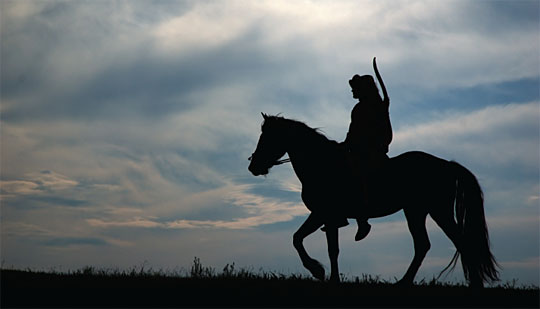
How does this tie into the global educational aspects of the World Ride?
“Let’s face it, television and video games encourage childhood obesity and discourage an interest in geography. Who wants to look at maps when you can pretend you’re stealing a car in a video fantasy? We need to encourage kids to become explorers, otherwise you’re never going to inspire the next generation of students to understand and address the complex problems facing our planet. But if history has one lesson for us, it’s that children love horses. That’s why we’re asking teachers to help us link Earth’s horse-loving children in an educational project via the Internet. This way the World Ride inspires a new generation of Little Long Riders to take to the saddle, explore their world and use this journey to encourage geographic literacy.”
What kind of equestrian gear and tack will you use?
“This question is so complex that I devote several chapters to it in my forthcoming work, The Horse Travel Handbook. So let me focus on a couple of aspects. First, we’re not going home when it gets rainy, snowy, ugly, depressing, life-threatening or even boring. When we swing into the saddle in Paris, we won’t step down until we ride back to the Eiffel Tower. So that resolve also means that despite any climatic challenges, we’ll ride year round, stopping only when the weather prevents us from continuing on in safety. And while the subject of tack is a complex one, I want to say that I have been fortunate enough to be entrusted with a legendary saddle. Captain Otto Schwarz was the Swiss Long Rider who rode 48,000 kilometres (30,000 miles) across five continents, making him the most well traveled Long Rider of the 20th century. Just before his recent death, Otto gave me his Swiss cavalry saddle. It had already seen service in both World Wars, before Otto traveled in it. So every time I swing into that saddle, it will be in recognition of all those Historical Long Riders, like Otto, who rode before me.”
Even though you’re both experienced equestrian explorers, you’ve asked for help from other experts. Who is helping you and why?
“Listen, anyone who thinks that riding towards the sunset is easy hasn’t ever suffered in the saddle. There’s a vast difference between a trail ride and an equestrian expedition, especially one as complicated and lengthy as this one. That’s why we’ve asked for the assistance of the world’s leading exploration experts like Sweden’s legendary Long Rider, Mikael Strandberg, who crossed Siberia in winter temperatures of minus sixty degrees. He is advising us on the Russian portion of our route. What his involvement indicates is how serious this journey is.”
What sort of dangers do you think you will encounter?
“What most people don’t realize is that there is a fundamental difference between the reception afforded to humanity’s two legendary types of travelers. A sailor and his ship are traditionally greeted in every port. But that sense of jovial welcome stands in stark contrast to the cold hostility, which equestrian travelers have endured throughout the ages. For unlike a harbor, which is usually inhabited by sympathetic sea people, border guards are antagonistic by nature and training to horse travelers. So while most people will make the mistake of thinking that our greatest threat is from bandits or wild animals, in fact it’s the diplomatic barbed wire that scares the hell out of us.”
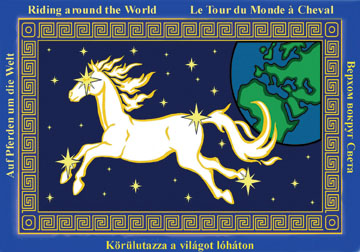
Is there anything you wish to add?
“It’s important for the public to realize that this expedition is only a portion of the new Long Riders’ Guild Academic Foundation, the purpose of which is to educate people regarding equestrian exploration, research and publishing. Even though the LRGAF is sponsoring the World Ride as its first official expedition, there will be more journeys to follow. The organization has numerous publishing projects in the works, including the first global analysis of equine training, not to mention a study of modern North American equestrian tribalism. All of these projects demonstrate why it’s essential that horse riders and readers support this unique new academic effort, whose motto is ‘Science not Superstition’.”

